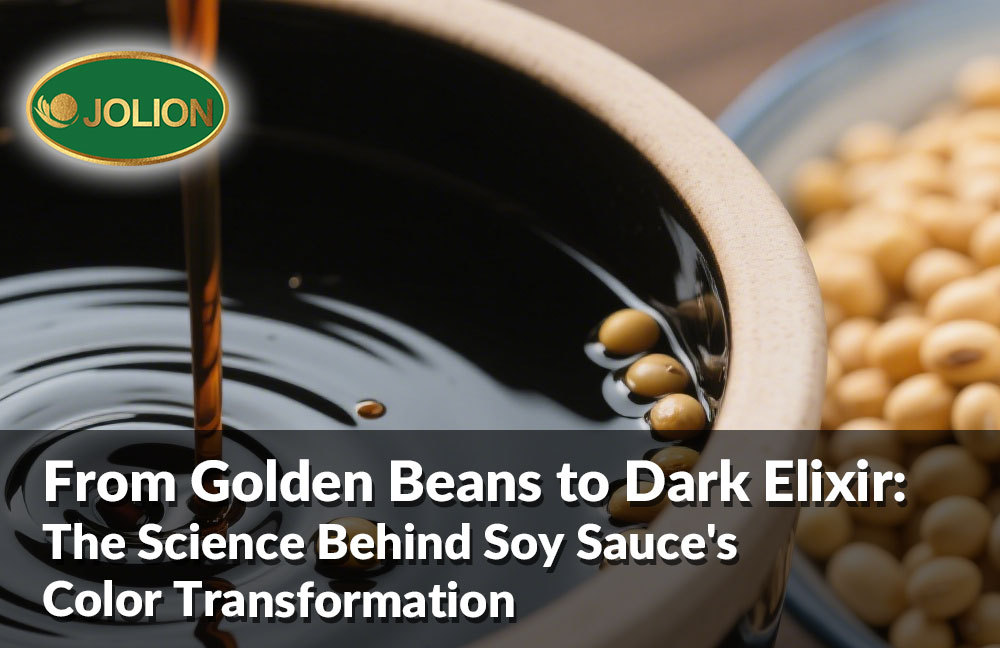
- Elevate Your Dishes with JOLION Foods’ 500G Chicken Base Powder2025-11-02JOLION Foods, a renowned chicken powder manufacturer, provides an exceptional solution with its 500G Chicken Base Powder Chicken Powder.
- Discover JOLION Foods: Your Premier Wholesale Sauce Supplier2025-11-01JOLION Foods Company, a wholesale sauce supplier, has emerged as a leader in this sector since its inception in the 2000s in Zhongshan City, China.
- How to Start a Sauce Business in 7 Steps2025-12-01
From Golden Beans to Dark Elixir: The Science Behind Soy Sauce's Color Transformation
From Golden Beans to Dark Elixir: The Science Behind Soy Sauce's Color Transformation
Walk down any grocery store aisle, and you’ll notice soy sauce’s rich, dark hue—a stark contrast to the pale yellow soybeans from which it originates. This dramatic color shift isn’t just a coincidence; it’s the result of a fascinating interplay of biology, chemistry, and time. Let’s unravel the scientific journey that turns golden soybeans into the inky liquid we know as soy sauce.

The Starting Point: Soybeans in Their Natural State
Soybeans, in their raw form, boast a light yellow color, derived from natural pigments like carotenoids—antioxidants that also give carrots and sweet potatoes their vibrant tones. When harvested, these legumes are firm, starchy, and far from the dark liquid they’ll become. Their transformation begins with a series of intentional steps, each designed to unlock not just flavor but also trigger chemical reactions that alter their color.
Step 1: Cooking—Breaking Down Barriers
The first step in soy sauce production—cooking the soybeans—sets the stage for color change. Soybeans are soaked in water and then steamed or boiled, a process that softens their tough outer shells and breaks down complex carbohydrates into simpler sugars. This initial heat treatment doesn’t drastically change their color (they may turn a paler, creamier yellow), but it makes the beans’ components more accessible for the reactions to come.
Step 2: Fermentation—Microbes Take the Lead
Fermentation is where the magic (and the darkening) truly begins. After cooking, soybeans are mixed with roasted wheat (or other grains) and inoculated with mold cultures, typically Aspergillus oryzae or Aspergillus sojae. These microbes feast on the beans’ sugars and proteins, producing enzymes that kickstart a cascade of chemical changes.
One key byproduct of this microbial activity is melanin—a pigment found in everything from human skin to fungi. As the mold grows, it generates melanin-like compounds that give the mixture a slight brown tint. But this is just the beginning; the real color transformation happens when saltwater brine is added, and the mixture enters a months-long fermentation period.
Step 3: The Maillard Reaction—Nature’s Color Chemist
During fermentation, the soy-salt mixture undergoes the Maillard reaction, a chemical dance between amino acids (from broken-down proteins) and reducing sugars (from carbohydrates). Named after French chemist Louis-Camille Maillard, this reaction is responsible for the browning of bread crusts, seared steaks, and, yes, soy sauce.
In the warm, moist environment of fermentation tanks, amino acids and sugars react to form hundreds of new compounds, including melanoidins—large, complex molecules that range in color from amber to deep brown. As fermentation progresses, these melanoidins accumulate, darkening the liquid. The longer the fermentation (often 6 months to 2 years for traditional soy sauce), the more pronounced this browning becomes, resulting in a richer, darker color.
Step 4: Caramelization and Additional Factors
In some varieties, especially dark soy sauce, producers intentionally enhance the color through caramelization. This involves heating sugars (either from the beans or added separately) until they break down into brown, sweet-tart compounds. Caramel not only deepens the color but also adds a subtle sweetness that balances soy sauce’s saltiness.
Other factors play a role too. The type of grain used (wheat vs. barley, for example) affects sugar content and thus the intensity of the Maillard reaction. Salt concentration also matters: higher salt levels slow fermentation but can lead to more concentrated color development over time.
Why Color Matters: More Than Just Appearance
The dark color of soy sauce isn’t just for show—it’s a visual clue to its flavor profile. Lighter soy sauces (like Japanese usukuchi or Chinese shengchou) undergo shorter fermentation, resulting in fewer melanoidins. They’re paler, saltier, and brighter, ideal for dishes where color preservation matters, such as clear soups or light stir-fries.
Darker varieties, however, with their abundance of melanoidins and caramel notes, offer deeper umami, milder saltiness, and a rich, almost smoky flavor. These are perfect for braises, marinades, and sauces where a bold color and taste are desired.
Conclusion: A Symphony of Science and Tradition
From golden soybean to inky elixir, soy sauce’s color transformation is a testament to the power of fermentation, chemistry, and patience. It’s a process that balances microbial activity, heat, and time to create not just a condiment, but a culinary chameleon—adapting its hue and flavor to suit dishes across cultures. The next time you pour soy sauce into a stir-fry or dip, take a moment to appreciate the scientific journey that turned a humble bean into something so deeply complex.
Related News
- 2025-11-02Elevate Your Dishes with JOLION Foods’ 500G Chicken Base Powder
- 2025-11-01Discover JOLION Foods: Your Premier Wholesale Sauce Supplier
- 2025-12-01How to Start a Sauce Business in 7 Steps
- 2025-12-01How Long Can Canned Foods Last?
- 2025-11-28Chili Powder: Crafting, Usage, and Custom Spices & Sauces Solutions for B2B Partners
- 2025-11-28Curry Powder: Crafting, Usage, and Customized Solutions for B2B Partners
Start Your Seasoning Sauce Business by a Free Quote
GET FREE QUOTES
If you are interested in our services, let's have a try on the first project
